This section is my opportunity to display the fraktur pieces I consider the most beautiful and meaningful. Personal preference explains the prominence of Mennonite and Schwenkfelder work from Bucks and Montgomery Counties. I find these schools to be the richest of the genre.

In a sense, American fraktur began at this other-worldly monastic settlement in Lancaster County. Fraktur, in the form of wall charts and hymnal decoration, was being made in the scriptorium as early as the 1730s. Yet, the typical style of Ephrata stayed at Ephrata. While the cloister’s printing presses turned out contract work for other artists to fill in, the uniquely delicate pastels and the soft blue of hand-drawn Ephrata work were never replicated. Seeing actual pieces at Ephrata is a very different experience than viewing reproductions. The difference may be the environment of the remaining cloister buildings or that such delicate work loses impact in reproduction.
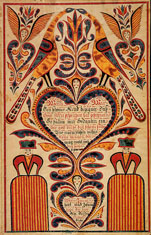
How is it that two sons of a rural eighteenth century Mennonite bishop and farmer in western Montgomery County discovered such a beautiful and reality-bending artistic vocabulary? That such a fluid and balanced design sense found expression through them makes one wonder about commonly used adjectives, such as “primitive” and “naive.” The Godshall brothers, Martin and Samuel, turned out work that is instantly recognizable but difficult to separate between them. It took Mary Jane Lederach Hershey to do it in her wonderful book, This Teaching I Present, Fraktur from the Skippack and Salford Mennonite Meetinghouse Schools, 1747-1836. Visit the Mennonite Heritage Center, Harleysville, PA, to explore the topic.
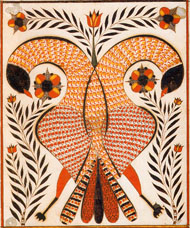
Mennonite work from the Franconia region of Bucks and Montgomery Counties is marked by vibrant color and meticulous precision and balance. The work of David Kulp is exemplary. It is germane that he was a product of Deep Run, a school on the grounds of the Mennonite meeting house of the same name in upper Bucks County. Deep Run is typical of the culturally conservative subscription schools that lasted well into the era of state supported districts. The lineage of fraktur-producing school masters at Deep Run, Salford, Skippack and others is an honor roll of great artists. The “new” 1842 building at Deep Run still stands, remarkably unchanged from the time when Henry Mercer recognized its significance and photographed it in 1897.
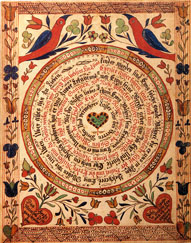
Johan Adam Eyer was not a Mennonite but is the best example of a handful of schoolmasters who, while not baptized members of the community, were welcome leaders of its culture. Eyer’s wide-ranging influence earns him a place on this page. His biography reveals restlessness, with stints in Bucks, Chester, Lancaster, Northampton and Monroe counties, though he often returned to Bucks and the network of Mennonite schools described above. Much of his best work are decorated student copy books and writing models, called Vorschriften. Eyer’s exuberant, vibrant compositions are exciting in their own right and form an aesthetic heritage that plays out over generations. He directly influenced Andreas Kolb, David Kulp, and the Godshalls, as well as Lancaster County artists Christian Strenge and Christian Alsdorf.
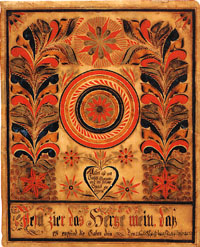
I enjoy watching the reaction of those hearing the term “Schwenkfelder” for the first time. This perpetually small but historic Pennsylvania German sect settled in mid- and upper-Montgomery County in the early eighteenth century and stayed ever since. Their distinctive heritage gives the fraktur a different cast, one aspect of which is exemplified by Reverend David Kriebel’s lush foliage and dense composition. Dr. Donald Shelley wondered whether their European homeland, closer to eastern Europe than those of other Pennsylvania Germans, exposed them to a different aesthetic. The Schwenkfelder Library and Heritage Center in Pennsburg, PA, is a center of research.

Hand written text has a special place in Schwenkfelder culture, stemming from the difficulty of printing and distributing their religious texts in Europe. That gives this piece, the Seven Rules of Wisdom, special meaning, as does the fact that it was done by the best known female fraktur artist, Susanna Heebner. The text describes the humble sectarian Pennsylvania German mind set. I provide a translation. Samuel Godshall (above) also did a magnificent Seven Rules.
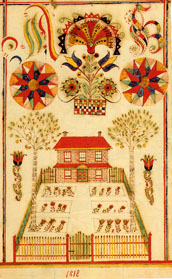
This piece, also by Susanna Heebner, captures an important aspect of the fraktur aesthetic. The mood of peaceful and balanced domesticity are clear (and the architecture and garden style instantly recognizable to anyone familiar with the typical Pennsylvania German household). These are found, however, within a universe of vibrant and even explosive color and design. The pastoral scene serves as vehicle for another reality. That sense of messaging and separate reality gives rise to unresolved debate among fraktur researchers. Scholars Dennis Moyer and Candace Perry point out that Heebner probably copied part of this piece from one by Schwenkfelder minister Melchoir Schultz. Reverend Schultz’s home in Worcester Township, purchased in 1794 and occupied by his descendents until 1969, is now known as the Peter Wentz Homestead. It indeed bears a rough resemblance to this fraktur depiction.
The vast majority of Pennsylvania Germans are members of mainline Protestant denominations, such as the Lutheran and German Reformed (U.C.C.) churches. Baptism of an infant is a critical passage in the culture and was recorded in a document called the Taufschein. Before printed forms became common, hand-written Taufscheine proliferated and many are quite beautiful. For example:
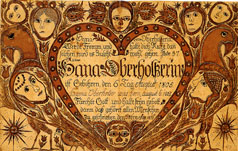
David Cordier’s compositions are very consistent in many respects and especially in their haunting sensibility. It is impossible to glance at Cordier piece – you must lock eyes with it. Little was known about Cordier until Lisa Minardi, Winterthur Museum, recently discovered record of him in the Miami River valley of Ohio. Much remains to discover about major fraktur artists.
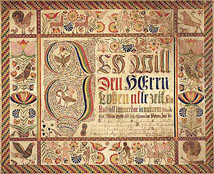
George Geistweit was a circuit-riding Reformed minister and schoolmaster in Centre County from 1794-1804. His body of work is small and we know of only two writing models he turned out in 1801 and 1802. They are among the grandest of all fraktur (and one holds the price record at auction). This piece has been subjected to intense scrutiny by the symbolist school of fraktur interpretation, which I find irrelevant to its magnificence.




